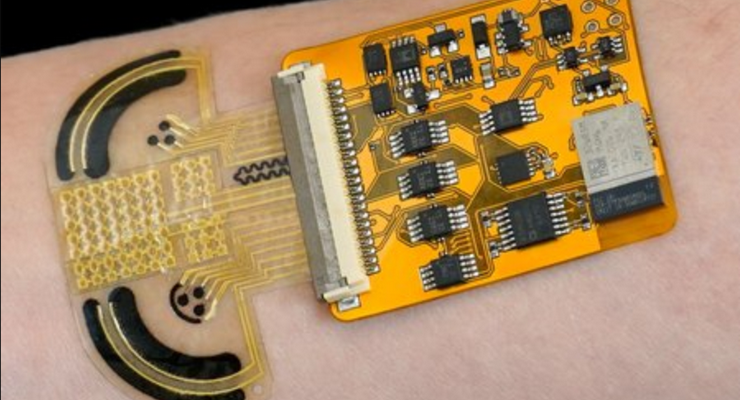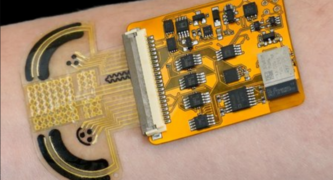
Fully integrated wireless CARES device. Credit: Wei Gao and Changhao Xu
In the latest of a series of innovative designs for wearable sensors that use sweat to identify and measure physiological conditions, Caltech’s Wei Gao, assistant professor of medical engineering, has devised an “electronic skin” that continuously monitors nine different markers that characterize a stress response. Those wearing this electronic skin—a small, thin adhesive worn on the wrist, called CARES (consolidated artificial-intelligence-reinforced electronic skin)—are free to engage in all their normal daily activities with minimal interference during testing, which allows for the measurement of both baseline and acute levels of stress.
Stress is a slippery concept. We talk about “feeling stressed” or a situation “being stressful,” and we may attach stress to physical symptoms: “I have a stress headache” or “I’m grinding my teeth at night. It must be stress.” The term stress can apply to all sorts of feelings, symptoms, behaviors, and experiences.
Hans Selye, a physician and chemist born in Vienna in 1907, was the first to define stress as a medical condition. Struck by the similar complaints—such as tiredness, low appetite, and lack of motivation—that he heard from patients suffering from very different illnesses, Selye speculated that all of the patients were responding to what they had in common: being sick. He defined stress as a “nonspecific response of the body to any demand.”
Stress may be experienced positively as excitement or energy, or negatively as shock or anxiety. But however stress may be experienced emotionally, it is now widely agreed that depending on its severity and duration, both acute and chronic stress can damage our physical and mental health, and reduce our ability to function as we would like.
Because stress is, as Selye described it, “nonspecific,” there is no single biomarker available to tell us definitively whether or how much a person is stressed. However, stress generates a constellation of bodily reactions that, taken together, can provide a measure of stress independent of self-reports. Gao is monitoring this constellation with CARES.
“When a person is under stress, hormones like epinephrine, norepinephrine, and cortisol are released into the bloodstream,” explains Gao, who is also an investigator with the Heritage Medical Research Institute and a Ronald and JoAnne Willens Scholar. “Sweat becomes rich with metabolites like glucose, lactate, and uric acid, and electrolytes like sodium, potassium, and ammonium. These are substances we have measured before using microfluidic sampling on a wearable sweat sensor. What is new in CARES is that sweat sensors are integrated with sensors that record pulse waveforms, skin temperature, and galvanic skin response: physiological signals that also indicate stress in predictable ways.”
New materials further boost the performance of CARES. Though previously used materials for sweat sensors could be produced efficiently via inkjet printing and were capable of accurate measurement of even very scarce compounds, the materials gradually broke down in the presence of bodily fluids. The introduction of a nickel-based compound helps to stabilize the enzymatic-based sensors, such as those that detect lactate or glucose, as does a new polymer added to the ion-based sensors, which detect biomarkers like sodium or potassium. “Adding these new materials greatly enhances the sensor stability during long-term operation,” Gao reports. Like previous sweat sensors, CARES can be battery powered and can wirelessly communicate with a phone or computer via Bluetooth.
Another important innovation with CARES is the addition of machine learning. Because stress comes in many different forms and stimulates a complex response affecting many different bodily systems, interpreting a wealth of data accurately is key to the usefulness of CARES and other sensors. Experiments inducing stress in subjects wearing the CARES device demonstrated that the sensor accurately measures the interrelatedness of physiological (such as pulse) and chemical (such as glucose) biomarkers. Subjects also answered questionnaires to self-report their feelings of anxiety and psychological stress before and after exposure to stressful situations like vigorous exercise or intense video gameplay. Data showed clear correlations between self-reports of stress and its physicochemical correlates as measured by CARES.
“High levels of stress and anxiety caused by demanding work environments, such as those experienced by soldiers or astronauts, can significantly affect performance,” Gao notes. “Early detection of the severity of stress allows for timely intervention. Our wearable sensor, combined with machine learning, has the potential to provide real-time stress-level insights.”
The paper describing the CARES device, titled “A physicochemical sensing electronic skin for stress response monitoring,” appears in the January 19 issue of Nature Electronics. Co-authors are Changhao Xu (MS ’20), Yu Song, Juliane R. Sempionatto, Samuel R. Solomon (MS ’23), You Yu, Roland Yingjie Tay, Jiahong Li, Wenzheng Heng (MS ’23), Jihong Min (MS ’19), and Alison Lao of Caltech; Hnin Y. Y. Nyein of Hong Kong University of Science and Technology; and Tzung K. Hsiai and Jennifer A. Sumner of UCLA.
Funding for the research was provided by the Translational Research Institute for Space Health through NASA, the Office of Naval Research, the Army Research Office, the National Institutes of Health, the National Science Foundation, the National Academy of Medicine, and the Heritage Medical Research Institute.














 1 comment
1 comment


